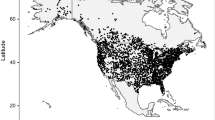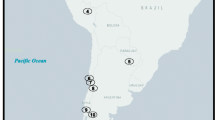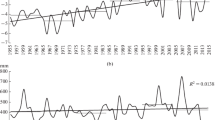Abstract
An age-old pursuit of biologists has been to relate the distribution and abundance of organisms to some aspect of their environment. Factors influencing their evolution, reproductive success, dispersal and migration, and other aspects of their ecology have been investigated. These pursuits have ranged from qualitative descriptions of plant and animal distributions and associations to quantitative statistical analyses of the interrelationships of plants, animals, and their environment.
Access this chapter
Tax calculation will be finalised at checkout
Purchases are for personal use only
Preview
Unable to display preview. Download preview PDF.
Similar content being viewed by others
References
Ambuel, B., and Temple, S. A., 1983, Area-dependent changes in the bird communities and vegetation of southern Wisconsin forests. Ecology 64:1057–1068.
Atkinson, I. A. E., 1977, A reassessment of factors, particularly Rattus rattus L., that influenced the decline of endemic forest birds in the Hawaiian islands, Pacific Sci. 31:109–133.
Baker, D. S., Dill, H. H., and Nelson, H. K., 1968, Effect of predator reduction on waterfowl nesting success, J.Wildl. Manage. 32:669–682.
Baptista, L. F., and Johnson, R. B., 1982, Song variation in insular and mainland California Brown Creepers (Certhia familiaris), J. Ornithol. 123:131–144.
Barber, R. T., and Chavez, F. P., 1983, Biological consequences of El Nino, Science 222:1203–1210.
Bengston, S., and Block, D., 1983, Island land bird population densities in relation to island size and habitat quality on the Farse Islands, Oikos 41:507–522.
Berry, K. H., 1980, A review of the effects of off-road vehicles on birds and other vertebrates, in: Management of Western Forests and Grasslands for Nongame Birds, (R. M. DeGraff, ed.), USDA For. Serv. Gen. Tech. Rep. INT-86, pp. 451–467.
Blus, L., Henny, C. J., Lenhart, D. J., and Cromartie, E., 1979, Effects of heptachlor- treated cereal grains on Canada Geese in the Columbia Basin, in: Management and Biology of Pacific Flyway Geese: A Symposium (R. L. Jarvis and J. C. Bartonek, eds.), OSU Book Stores, Inc., pp. 105–116.
Bull, K. R., Every, W. J., Freestone, P., Hall, J. R., and Osborn, D., 1983, Alkyl lead pollution and bird mortalities on the Mersey Estuary, UK, 1979–1981, Environ. Pollut. Ser. A 31:239–259.
Burger, J., 1981, The effect of human activity on birds at a coastal bay, Biol. Conserv. 21:231–241.
Bury, R. L., 1978, Impacts of snowmobiles on wildlife, Trans. North Am. Wild!, and Natur. Resour. Conf. 43:149–156.
Butcher, G. S., Niering, W. A., Barry, W. J., and Godowin, R. H., 1981, Equilibrium biogeography and the size of nature preserves: an avian case study, Oecologia 49:29–37.
Cain, B. W., and Bunck, C. M., 1983, Residues of organochlorine compounds in Starlings [Sturnus vulgaris], 1979, Environ. Monit. Assess. 3:161–172.
Carson, R., 1962, Silent Spring, Houghton Mifflin, Boston.
Chesness, R. A., Nelson, M. M., and Longley, W. H., 1968, The effect of predator removal on pheasant reproductive success, J. Wildl. Manage. 32:683–697.
Clark, D. R., Jr., and Krynitsky, A. J., 1983, DDT: recent contamination in New Mexico and Arizona? Environment 25:27–31.
Clark, R. B., 1984, Impact of oil pollution on seabirds, Environ. Pollut. Ser. A 33:1–22.
Clegg, F. G., and Hunt, A. E., 1975, Salmonella infection in Mute Swans (Cygnus olor], Vet. Ree. 97:373.
Clements, F. C., 1920, Plant Indicators, Carnegie Institution of Washington, Washington, D. C.
Collins, B. G., and Briffa, P., 1982, Seasonal variation of abundance and foraging of three species of Australian honeyeaters, Australian Wildl. Res. 9:557–569.
Conner, R. N., 1981, Seasonal changes in woodpecker foraging patterns. Auk 98:562–570.
Council on Environmental Quality, 1972, Development of a continuing program to provide indicators and indices of wildlife and the natural environment. (Ecology Program, Smithsonian Institution, final report, 15 April 1972).
DeGraff, R. M., and Wentworth, J. M., 1981, Urban bird communities and habitats in New England, Trans. North Am. Wildl. and Natur. Resour. Conf. 46:396–413.
DeGroot, R. S., 1983, Tourism and conservation in the Galapagos Islands, Biol. Conserv. 26:291–300.
Diamond, J. M., 1975, The island dilemma: lessons of modern biogeographic studies for the design of natural reserves, BioJ. Conserv. 7:129–146.
Dingwall, P. R., Atkinson, I. A. E., and Hay, C. (eds.), 1978, The Ecology and Control of Rodents in New Zealand Nature Reserves, Information Series 4, Department of Lands and Survey, Wellington.
Douthwaite, R. J., and Fry, C. H., 1982, Food and feeding behavior of the Little Bee-eater Merops pusiJJus in relation to tsetse fly control by insecticides, Biol. Conserv. 23:71–78.
Durant, A. J., 1956, Impaction and pressure necrosis of the esophagus in Canada Geese due to eating dry hulled soybeans, J. Wildl. Manage. 20:399.
Dustman, E. H., Martin, W. E., Heath, R. G., and Reichel, W. L., 1971, Monitoring pesticides in wildlife, Pestic. Monit. J. 5:50–52.
Fimreite, N., 1979, Accumulation and effects of mercury on birds, in:The Biogeochem- istry of Mercury in the Environment (J. O. Nriagu, ed.), Elsevier/North Holland Biomedical Press, New York, pp. 601–627.
Fleming, W. J., Clark, D. R., Jr., and Henny, C. J., 1983, Organochlorine pesticides and PCB’s: a continuing problem for the 1980’s, Trans. North Am. Wildl. and Natur. Resour. Conf. 48:186–199.
Flickinger, E. L., 1981, Wildlife mortality at petroleum pits in Texas, J. Wildl. Manage. 45:561–564.
Folk, R. H., and Marchinton, R. L., 1980, Effects of intensive deer hunting on behavior of wild turkeys, J. Wildl. Manage. 44:922–927.
Friend, M., 1981, Waterfowl management and waterfowl disease: independent or cause and effect relationships? Trans. North Am. Wildl. and Natur. Resour. Conf. 46:94–104.
Geis, A. D., and Crissey, W. F., 1969, Effect of restrictive regulations on Canvasback and Redhead harvest rates and survival, J. Wildl. Manage. 33:860–866.
Getz, L. L., Best, L. B., and Prather, M., 1977, Lead in urban and rural songbirds, Environ. Pollut. 12:235–238.
Graber, J. W., and Graber, R. R., 1979, Severe winter weather and bird populations in southern Illinois, Wilson Bull. 91:88–103.
Grinnell, G. B., 1894, Lead poisoning, Forest and Stream 42:117–118.
Grue, G. E., and Shipley, B. K., 1984, Sensitivity of nestling and adult Starlings to di- crotophos, an organophosphate pesticide. Environ. Res. 35:454–465.
Grue, G. E., Fleming, W. J., Busby, D. G., and Hill, E. F., 1983, Assessing hazards of organophosphate pesticides to wildlife. Trans. North Am. Wildl. and Natur. Resour. Conf. 48:200–220.
Grue, G. E., O’Shea, T. J., and Hoffman, D. J., 1984, Lead concentrations and reproductive success in highway-nesting Barn Swallows, Condor 86:383–389.
Grue, G. E., Fecko, G. M., and Krynitsky, A. J., 1985, Pesticides are not responsible for recent declines in native bird populations on Guam, Micronesica (in press).
Haapanen, A., 1965, Bird fauna of the Finnish forests in relation to forest succession. I., Ann. Zooi. Fenn. 2:153–196.
Henny, G. J., Blus, L. J., and Stafford, G. J., 1983, Effects of heptachlor on American Kestrels in the Golumbia Basin, Oregon, J. Wildl. Manage. 47:1080–1087.
Henny, G. J., Blus, L. J., Krynitsky, A. J., and Bunck, G. M., 1984, Current impact of DDE on Black-crowned Night-herons in the intermountain west, J.Wildl. Manage. 48:1–13.
Henny, G. J., Blus, L. J., Kolbe, E. J., and Fitzner, R. E., 1985, Organophosphate cattle pour-on insecticide (Famphur) kills Black-billed Magpies and Red-tailed Hawks, J. Wildl. Manage. 49:648–658.
Hildén, O., 1965, Habitat selection in birds, Ann. Zool. Fenn. 2:53–75.
Hill, E. F., and Fleming, W. J., 1982, Anticholinesterase poisoning of birds: field monitoring and diagnosis of acute poisoning. Environ. Toxicol. Chem. 1:27–38.
Holmes, R. T., 1981, Theoretical aspects of habitat use by birds, in: The Use of Multivariate Statistics in Studies of Wildlife Habitat (D. E. Gapen, ed.), USDA For. Serv. Gen. Tech. Rep. RM-87, pp. 33–37.
Hutton, M., 1980, Metal contamination of feral pigeons Columba livia from the London area: part 2—biological effects of lead exposure, Environ. Pollut. Ser. A 22:281–293.
Hutton, M., and Goodman, G. T., 1980, Metal contamination of feral pigeons Columba livia from the London area: part 1—tissue accumulation of lead, cadmium and zinc. Environ. Pollut. Ser. A. 22:207–217.
Imber, M. J., 1968, Sex ratios in Canada Goose populations, J. Wildl. Manage. 32:905–920.
Järvinen, O., and Vaisänen, R. A., 1979, Changes in bird populations as criteria of environmental changes, Holarctic Ecol. 2:75–80.
Jensen, S., Johnels, A. G., Olsson, M., and Otterlind, G., 1969, DDT and PCB in marine animals from Swedish waters, Nature 224:247–250.
Johnson, R. E., Carver, T. C., and Dustman, E. H., 1967, Residues in fish, wildlife and estuaries, Pestic. Monit. J. 1:7–13.
Johnston, D. W., and Odum, E. P., 1956, Breeding bird populations in relation to plant succession on the Piedmont of Georgia, Ecology 37:50–62.
Kirsch, L. M., Duebbert, H. F., and Kruse, A. D., 1978, Grazing and haying effects on habitats of upland nesting birds, Trans. North Am. Wildl. and Natur. Resour. Conf. 43:486–497.
Koeman, J. H., 1979, Chemicals in the environment and their effects on ecosystems, in: Advances in Pesticide Science, Part 1, World Food Production-Environment-Pesti- cides (H. Geissbuhler, ed.), Pergamon Press, Oxford, pp. 25–38.
Lack, D., 1954, The Natural Regulation of Animal Numbers, Oxford University Press, London.
Locke, L. N., Dewitt, J. B., Menzie, C. M., and Kerwin, J. A., 1964, A merganser die-off associated with larval Eustrogylides. Avian Dis. 8;420.
Luckenbach, R. A., 1978, An analysis of off-road vehicle use on desert avifauna, Trans. North Am. Wildl. and Natur. Resour. Conf. 43:157–162.
MacArthur, R. H., and Wilson, E. O., 1967, Theory of Island Biogeography, Princeton University Press, Princeton.
Mannan, R. W., Morrison, M. L., and Meslow, E. C., 1984, Comment: The use of guilds in forest bird management, Wildl. Soc. Bull. 12:426–430.
May, R. M., 1975, Island biogeography and the design of wildlife preserves. Nature 254:177–178.
McCoy, E. D., 1983, The application of island-biogeographic theory to patches of habitat: how much land is enough? Biol. Conserv. 25:53–61.
Merriam, C. H., 1898, Life zone and crop zones, U.S. Dept. Agric. Biol. Serv. Bull 10.
Morrison, M. L., and Meslow, E. C., 1983, Impacts of forest herbicides on wildlife: toxicity and habitat alteration, Trans. North Am. Wildl. and Natur. Resour. Conf. 48:175–185.
Morton, M. L., 1978, Snow conditions and the onset of breeding in the mountain White- crowned Sparrow, Condor 80:285–289.
Mueller-Dombois, D., and Ellenberg, H., 1974, Aimsand Methods of Vegetation Ecology, John Wiley and Sons, New York.
Newman, J. R., 1979a, Effects of industrial air pollution on wildlife, Biol. Conserv. 15:181–190.
Newman, J. R., 1979b, The effects of air pollution on wildlife and their use as biological indicators, in: Animals as Monitors of Environmental Pollutants, National Academy of Sciences, Washington, D.C., pp. 223–232.
Odum, E. P., 1971, Fundamentals of Ecology, 3rd ed., W. B., Saunders Co., Philadelphia.
Ohi, G., Seki, H., Akiyama, K., and Yagyo, H., 1974, The pigeon, a sensor of lead pollution. Bull. Environ. Contam. Toxicol. 12:92–98.
Ohi, G., Seki, H., Minowa, K., Ohsawa, M., Mizoguchi, I., and Sugimori, F., 1981, Lead pollution in Tokyo—the pigeon reflects its amelioration. Environ. Res. 26:125–129.
Ohlendorf, H. M., Hoffman, D. J., Saiki, M. K., and Aldrich, T. W., 1985, Impaired reproduction of aquatic birds in California: Impacts by selenium from irrigation drainwater. Sei.Total Environ, (in press).
Paloheimo, J. E., and Eraser, D., 1981, Estimation of harvest rate and vulnerability from age and sex data, J. Wildl. Manage. 45:948–958.
Pattee, O. H., and S. K. Hennes, 1983, Bald Eagles and waterfowl: The lead shot connection, Trans. North Am. Wildl. and Natur. Resour. Conf. 48:230–237.
Pianka, E. R., 1972, Evolutionary Ecology, Harper and Row, New York.
Potts, G. R., 1977, Population dynamics of the Grey Partridge: Overall effects of herbicides and insecticides on chick survival rates, Proc. Int. Congr. Game Biol. 13:203–211.
Power, D. M., 1983, Variability in island populations of the House Finch, Auk 100:180–187.
Ralph, C. J., and Scott, J. M., (eds.), 1981, Estimating Numbers of Terrestrial Birds, Studies in Avian Biology No. 6.
Raphael, M. G., and White, M., 1984, Use of snags by cavity-nesting birds in the Sierra Nevada, Wildl. Monogr. 86:1–66.
Ratcliffe, D. A., 1967, Decrease in eggshell weight in certain birds of prey, Nature 215:208–210.
Rotenberry, J. T., 1981, Why measure bird habitat? in: The Use of Multivariate Statistics in Studies of Wildlife Habitat (D. E. Capen, ed.), USDA For. Serv. Gen. Tech. Rep. RM-87, pp. 29–32.
Savidge, J. A., 1984, Guam: Paradise lost for wildlife, Biol. Conserv. 30:305–317.
Schreiber, R. W., and Schreiber, E. A., 1984, Central Pacific seabirds and the El Nino southern oscillation: 1982–1983 perspectives, Science 225:713–716.
Schroeder, M. H., 1970, Mourning Dove production in a Kansas osage orange planting, J. Wildl. Manage. 34:344–348.
Shaffer, M. L., 1981, Minimum population size for species conservation, Bioscience 31:131–134.
Shugart, H. H., Jr., and James, D., 1973, Ecological succession of breeding bird populations in northwestern Arkansas, Auk 90:62–77.
Simberloff, D., and Abele, L. G., 1982, Refuge design and island biogeography theory: effects of fragmentation, Am. Nat. 120:41–50.
Smith, K. G., 1982, Drought-induced changes in avian community structure along a montane sere. Ecology 63:952–961.
Stanley, P. I., and Bunyan, P. J., 1979, Hazards to wintering geese and other wildlife from the use of dieldrin, chlorfenvinfos and carbophenothion as wheat seed treatments, Proc. R. Soc. Lond. 205:31–45.
Steiner, A. J., and Leatherman, S. P., 1981, Recreational impacts on the distribution of ghost crabs Ocypode quadrata Fab.,Biol. Conserv. 20:111–122.
Stickel, L., 1973, Pesticide residues in birds and mammals, in: Environmental Pollution by Pesticides (C. A. Edwards, ed.). Plenum Press, London, pp. 254–312.
Stickel, W. H., 1975, Some effects of pollutants in terrestrial ecosystems, in: Ecological Toxicology Research (A. D. Mclntyre and C. F. Mills, eds.). Plenum Press, New York, pp. 25–74.
Tansy, M. F., and Roth, R. P., 1970, Pigeons: a new role in air pollution, Air Pollut. Control. Assoc. J. 20:307–309.
Thomas, J. W., Anderson, R. G., Moser, G., and Bull, E. L., 1979, Snags, in: WiJdiie Habitats in Managed Forests. The Blue Mountains of Oregon and Washington (J. W. Thomas, ed.), USDA For. Serv. Agric. Handb. No. 553.
Thornburg, D. D., 1973, Diving duck movements on Keokuk Pool, Mississippi River, J. Wildl. Manage. 37:382–389.
van Riper, G., van Riper, S. G., Geogg, M. L., and Laird, M., 1982, The impact of malaria on birds in Hawaii Volcanoes National Park, Coop. Nat. Park Res. Stud. Unit, Univ. Hawaii, Manoa, Tech. Rep. 47.
Verner, J., 1983, An integrated system for monitoring wildlife on the Sierra National Forest, Trans. North Am. Wildl. and Natur. Resour. Conf. 48:355–366.
Walcott, G. F., 1974, Ghanges in bird life in Cambridge, Massachusetts from 1860 to 1964, Auk 91:151–160.
Warner, R. E., 1968, The role of introduced diseases in the extinction of the endemic Hawaiian avifauna, Condor 70:101–120.
Welty, J. G., 1975, The Life of Birds, Second Edition, W. B. Saunders Go., Philadelphia.
Whittaker, R. H., 1975, Communities and Ecosystems, 2nd ed., MacMillan, New York.
Wiley, J., 1985, Bird conservation in the United States Caribbean, Bird Conserv. 2:(in press).
Williamson, K., and Batten, L., 1977, Ecological implications of the Common Bird Census, Polish Ecol. Studies 3:237–244.
Winstanley, D., Spencer, R., and Williamson, K., 1974, Where have all the Whitethroats gone? Bird Study 21:1–14.
Wobeser, G. A., 1981, Diseases of Wild Waterfowl, Plenum Press, New York.
Woolhouse, M. E. J., 1983, The theory and practice of the species-area effect, applied to the breeding birds of British woods, Biol. Conserv. 27:315–332.
Wunderle, J. M., Jr., 1983, A shift in the morph ratio dine in the Bananaquit on Grenada, West Indies, Condor 85:365–367.
Zicus, M. C., 1981, Flock behavior and vulnerability to hunting of Canada Geese nesting at Crex Meadows, Wisconsin, J. Wildl. Manage. 45:830–841.
Zonneveld, I. S., 1983, Principles of bio-indication. Environ. Monitor. Assess. 3:207–217.
Author information
Authors and Affiliations
Editor information
Editors and Affiliations
Rights and permissions
Copyright information
© 1986 Plenum Press, New York
About this chapter
Cite this chapter
Morrison, M.L. (1986). Bird Populations as Indicators of Environmental Change. In: Johnston, R.F. (eds) Current Ornithology. Current Ornithology, vol 3. Springer, Boston, MA. https://doi.org/10.1007/978-1-4615-6784-4_10
Download citation
DOI: https://doi.org/10.1007/978-1-4615-6784-4_10
Publisher Name: Springer, Boston, MA
Print ISBN: 978-1-4615-6786-8
Online ISBN: 978-1-4615-6784-4
eBook Packages: Springer Book Archive




